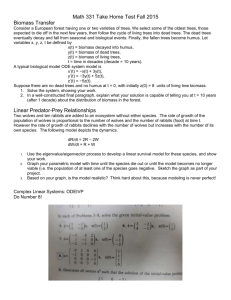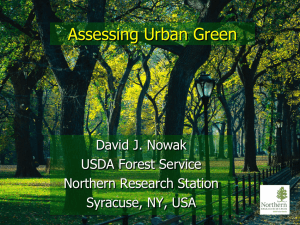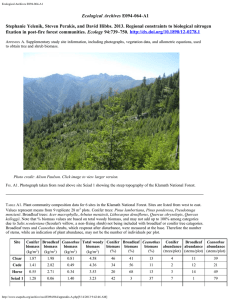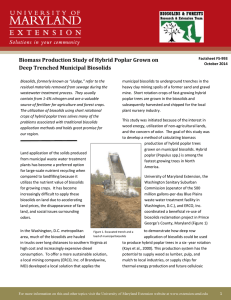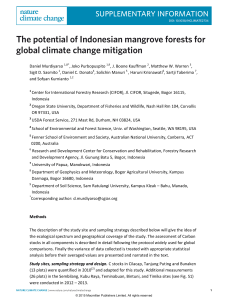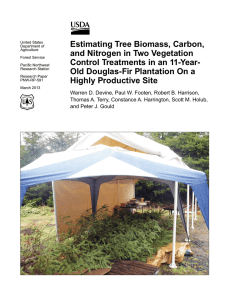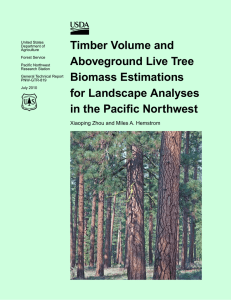ufore - i-Tree
advertisement
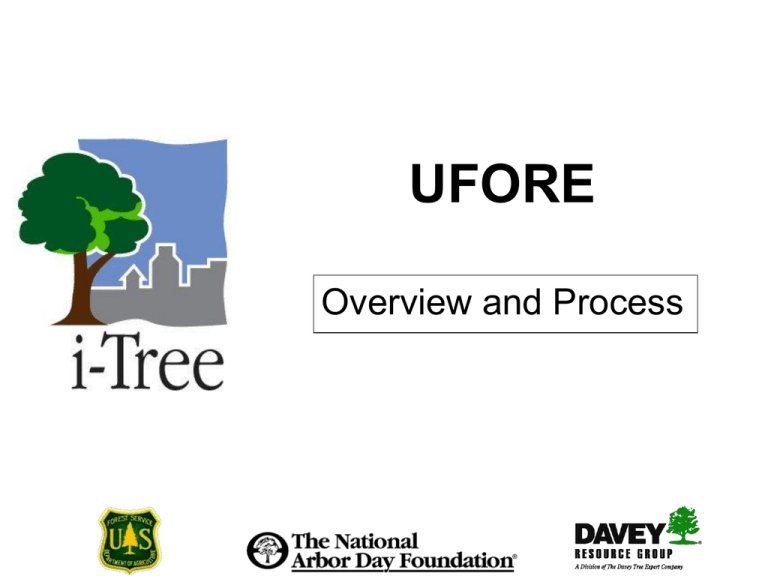
UFORE Overview and Process Overview & Process I What is UFORE? Science-based computer model that quantifies urban forest structure, functions, and values Collection of analysis tools Body of SAS code accessible through USDA Forest Service in Syracuse Specialized analysis for urban ecosystems Overview & Process I Ecosystem “Functional units of interacting abiotic, biotic, and cultural (anthropogenic) components” Includes all trees Public/private Native/exotic/utopian No systematic management of individuals, but we can and--many believe--must manage the population Population contributes to common good at much reduced cost/benefit ratio than street trees Overview & Process II Status of UFORE Fully operational as program at Syracuse running in SAS code Being converted to desktop app for Windows OS Conversion work will occupy next few years Major advances for i-Tree: Data collection app Reporting mechanism i-Tree 1.0 INPUT UFORE i-Tree 1.0 OUTPUT Overview & Process III Designed for ecosystem analysis Calculates Structure, e.g. Leaf area and biomass Species and DBH distribution Function, e.g. VOC emissions Pollution removal Effect on building energy use Total carbon stored and net carbon sequestered annually Value based on structure, function 1 metric ton (“tonne”) = 1.10231131 US (short) ton Overview & Process IV What good is it? Aid planning and management Improve forest designs Project future impacts Assess impact of catastrophic events Justify programs Source: http://www.houstonregionalforest.org/Report/ Overview & Process V How does it work? Uses field data to calculate structure Uses structure data to calculate function Uses function data to calculate value Uses value data to make recommendations The Devil lurks, as always, in the details 3 questions Ask when evaluating models: Do I understand the numbers? Can I trust the numbers? Can I use the numbers? I want to drill down one level in an effort to answer these questions Overview & Process VI Where do the numbers come from? Let’s examine one relatively *simple* set of calculations: CARBON Start with allometric¹ equations estimating above-ground biomass from species and DBH ¹ = relation of the growth of a part of an organism to the growth of the whole Regression of DBH as predictor of biomass Source: http://www.greenhouse.gov.au/ncas/reports/pubs/tr05afinal.pdf Overview & Process VI Convert with species-specific conversion factor: above-ground biomass whole tree biomass Adjust for 80% less biomass for open-grown urban trees than computed Based on field measurements of 30 urban trees in Chicago Nowak 1994 publication (Chicago study) How much of biomass is carbon? Divide biomass by 0.5 to derive stored carbon (Chow and Rolfe 1989) UFORE: SAS code segment /* ADJUST LEAF AREA OF TREES FOR OVERLAP /* OF CROWNS WITHIN CANOPY /* Total the ground area of all the trees within each of the plots. /* In addition, use ID option of the PROC MEANS to retain the /* percent tree cover (P_TREE) of each of the plots. PROC SORT DATA = NEWTREES; BY PLOT LIVING TBM_TYPE; RUN; PROC MEANS SUM N DATA = NEWTREES NOPRINT; BY PLOT LIVING; VAR GRD_AREA LEAF_ARE TEMP_SH; ID P_TREE PLT_AREA; OUTPUT OUT = TARE_PLT SUM = TOT_CRWN TOT_LA TOT_SH N = TOT_NUM; RUN; Is this too MUCH??!! http://tell.fll.purdue.edu/JapanProj/FLClipart/Adjectives/heavy.gif Overview & Process VI Use growth and mortality rates for annual Start with published and/or field data for species and DBH class Adjust growth (C storage) for Site (e.g., park 1.78 times less growth than street) Growing season length Condition of tree Adjust mortality (C release) for % of condition class Rapid release (above ground, populated areas) Slow release (below ground, unpopulated areas) Growth - Mortality net annual C storage Overview & Process VI Value Multiply net annual stored C by $20.30/tC Based on the estimated marginal social costs of carbon dioxide emissions (Fankhauser, 1994). Stochastic model treats uncertainties in global warming research/debate as random variables. Provides a distribution of outcomes from which means can be calculated. Rough order-of-magnitude assessment. Does this help?! Are me?


